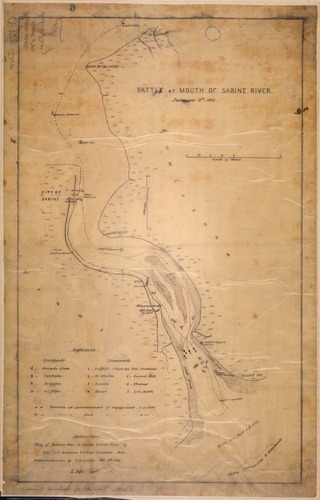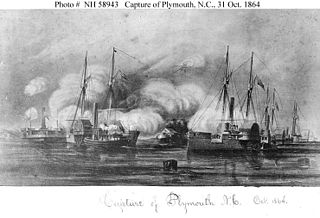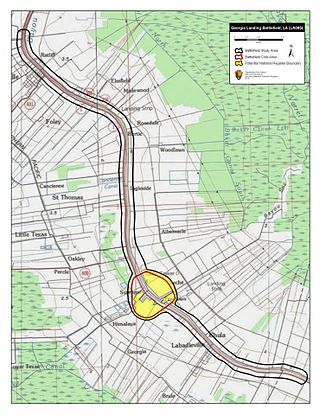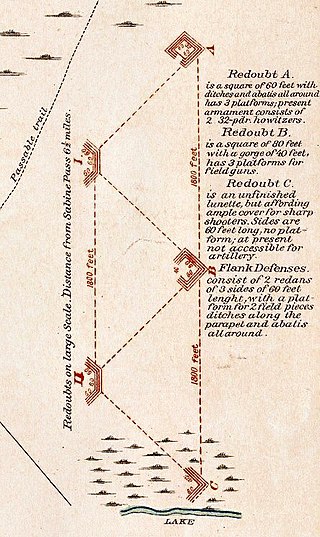
The Second Battle of Sabine Pass was a failed Union Army attempt to invade the Confederate state of Texas during the American Civil War. The Union Navy supported the effort and lost three gunboats during the battle, two captured and one destroyed.

USS Sciota was a Unadilla-class gunboat built on behalf of the United States Navy for service during the Civil War. She was outfitted as a gunboat, with both a 20-pounder rifle for horizontal firing, and two howitzers for shore bombardment, and assigned to the Union blockade of the waterways of the Confederate States of America.

The First Battle of Fort Fisher was a naval siege in the American Civil War, when the Union tried to capture the fort guarding Wilmington, North Carolina, the South's last major Atlantic port. Led by Major General Benjamin Butler, it lasted from December 24–27, 1864.

The Battle of Corydon was a minor engagement that took place July 9, 1863, just south of Corydon, which had been the original capital of Indiana until 1825, and was the county seat of Harrison County. The attack occurred during Morgan's Raid in the American Civil War as a force of 2,500 cavalry invaded the North in support of the Tullahoma Campaign. It was the only pitched battle of the Civil War that occurred in Indiana, and no battle has occurred within Indiana since.

The Battle of Secessionville was fought on June 16, 1862, during the American Civil War. Confederate forces defeated the Union's only attempt to capture Charleston, South Carolina, by land. It is noted for the court martial of the Union brigadier general Henry Benham for trying to take James Island, which was against the orders given.

The Battle of Irish Bend, also known as Nerson's Woods or Franklin, took place during the American Civil War. It was fought between Union Major General Nathaniel Prentice Banks against Confederate Major General Richard Taylor during Banks's operations against the Bayou Teche region near Franklin, the seat of St. Mary Parish in southern Louisiana.

The Battle of Baton Rouge was a ground and naval battle in the American Civil War fought in East Baton Rouge Parish, Louisiana, on August 5, 1862. The Union victory halted Confederate attempts to recapture the capital city of Louisiana.
The second United States Navy vessel to bear the name, USS Sachem was a screw steamer built in 1844 at New York City, where the U.S. Navy purchased her on 20 September 1861.

The Battle of Plymouth was an engagement during the American Civil War that was fought from April 17 through April 20, 1864, in Washington County, North Carolina.

The Battle of Georgia Landing or Battle of Labadieville was fought between a Union Army force led by Brigadier General Godfrey Weitzel and a Confederate States Army force commanded by Brigadier General Alfred Mouton near Labadieville, Assumption Parish, Louisiana, during the American Civil War. After a sharp clash, the Union troops compelled Mouton's outnumbered force to retreat.

USS Clifton was a shallow-draft side-wheel paddle steamer, built in 1861 at Brooklyn, as a civilian ferry. The Union Navy bought her early that December, and commissioned her after having her converted into a gunboat. In 1863 she ran aground, was captured and commissioned into the Texas Marine Department. Her career ended in 1864 when she ran aground and her Confederate crew burned her to prevent her recapture.
USS Wave was a steamer acquired by the Union Navy during the American Civil War. She was used by the Union Navy as a gunboat in support of the Union Navy blockade of Confederate waterways until she was herself captured by Confederate forces.
USS Granite City was a Confederate blockade runner steamer captured in March 1863 by the Union Navy during the American Civil War. She was armed with cannon and by August 1863 was in service as a gunboat in support of the Navy blockade of Confederate waters. She was recaptured in January 1864 by Confederate forces, again became a blockade runner, and ultimately was abandoned as a wreck after running aground.

Fort Manhassett was a group of earthen fortifications that guarded the western approaches to Sabine City, Texas during the American Civil War, operating in service of the Confederate Army from October 1863 to May 1865.
Hispanics in the American Civil War fought on both the Union and Confederate sides of the conflict. Not all the Hispanics who fought in the American Civil War were "Hispanic Americans" — in other words citizens of the United States. Many of them were Spanish subjects or nationals from countries in the Caribbean, Central and South America. Some were born in what later became a U.S. territory and therefore did not have the right to U.S. citizenship. It is estimated that approximately 3,500 Hispanics, mostly Mexican-Americans, Puerto Ricans and Cubans living in the United States joined the war: 2,500 for the Confederacy and 1,000 for the Union. This number increased to 10,000 by the end of the war.

The Second Battle of Pocotaligo, or Battle of Pocotaligo Bridge, or Battle of Yemassee, often referred to as simply the Battle of Pocotaligo, took place during the American Civil War on October 22, 1862 near Yemassee, South Carolina.

The Battle of Ponchatoula was a battle in Ponchatoula, Louisiana, and Ponchatoula Creek at the onset of the Vicksburg Campaign during the American Civil War. Fought from March 24 to March 26, 1863, the battle was part of an offensive campaign waged by the Union's 6th Michigan, 9th Connecticut, 14th Maine, 24th Maine, 165th New York Zouaves, and 77th New York infantry against Confederate troops to capture Ponchatoula for the Union and destroy the town's railroad bridge. This was ultimately a failure by the Union, as the outcome of the battle led to the Confederates regaining control of Ponchatoula.

The 2nd Louisiana Cavalry Regiment was a unit of mounted volunteers recruited in Louisiana that fought in the Confederate States Army during the American Civil War. Breazeale's Cavalry Battalion was formed in July 1862 and was augmented by five additional companies in September 1862 to form a regiment. It served for the entire war west of the Mississippi River in the Trans-Mississippi Department. The regiment fought at Georgia Landing, Fort Bisland, Irish Bend, and Brashear City in 1863 and Henderson's Hill and Mansfield in 1864. Afterward, the regiment fought in minor skirmishes before the Trans-Mississippi's final surrender on 26 May 1865.
The 21st Texas Infantry Regiment was a unit of volunteers recruited in Texas that fought in the Confederate States Army during the American Civil War. The regiment was formed in spring 1864 by consolidating William Henry Griffin's 21st Texas Infantry Battalion and Ashley W. Spaight's 11th Texas Cavalry Battalion. Spaight became colonel and Griffin became lieutenant colonel. Spaight's 11th Battalion existed as early as September 1862 with a strength of 400 men. In the 21st Regiment's only notable action, it ambushed and captured two Union gunboats in the Battle of Calcasieu Pass on 24 April 1864. The unit's duties were mainly guarding the Texas Gulf Coast. It moved to Marshall, Texas, in the winter of 1864–1865, then marched to Shreveport, Louisiana. In April 1865, the regiment returned to Texas before disbanding in May.














